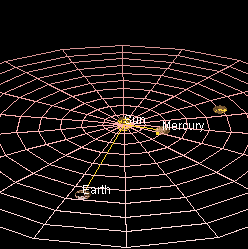Mercury is the innermost planet in the Solar System. It is also the smallest, and its orbit is the most eccentric (that is, the least perfectly circular) of the eight planets. It orbits the Sun once in about 88 Earth days, completing three rotations about its axis for every two orbits. The planet is named after the Roman god Mercury, the messenger to the gods.
Mercury's surface is heavily cratered and similar in appearance to Earth's Moon, indicating that it has been geologically inactive for billions of years. Due to its near lack of an atmosphere to retain heat, Mercury's surface experiences the steepest temperature gradient of all the planets, ranging from a very cold 100 K at night to a very hot 700 K during the day. Mercury's axis has the smallest tilt of any of the Solar System's planets, but Mercury's orbital eccentricity is the largest. The seasons on the planet's surface are caused by the variation of its distance from the Sun rather than by the axial tilt, which is the main cause of seasons on Earth and other planets. At perihelion, the intensity of sunlight on Mercury's surface is more than twice the intensity at aphelion. Because the seasons of the planet are produced by the orbital eccentricity instead of the axial tilt, the season does not differ between its two hemispheres.Mercury and Venus can each make appearances in Earth's sky both as a morning star and an evening star (because they are closer to the Sun than the Earth), and at times Mercury can technically be regarded as a very bright object when viewed from Earth; however, its proximity in the sky to the Sun makes it more difficult to see than Venus.
Orbit of Mercury
Orbit of Mercury
This is the rotation way of mercury around the Sun.










0 comments:
Post a Comment